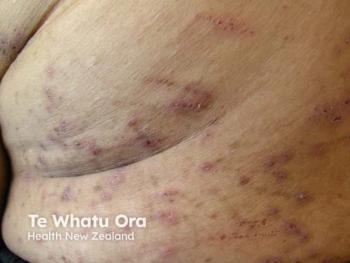
Virus a culprit? Merkel cell pathogen linked to up to a third of SCC tumors
The Merkel cell polyomavirus (MCPyV), first identified in rare aggressive Merkel cell carcinoma in 2008, has now been isolated in up to a third of patients with squamous cell carcinoma (SCC), according to a new study published online in the Journal of Investigative Dermatology.
Key Points
National report - The Merkel cell polyomavirus (MCPyV), first identified in rare aggressive Merkel cell carcinoma in 2008, has now been isolated in up to a third of patients with squamous cell carcinoma (SCC), according to a new study published online in the Journal of Investigative Dermatology.
Analysis of the MCPyV DNA suggests that a specific point mutation in its genome and integration into host cell DNA are key factors in turning a latent infection into a tumor, though causality and the mechanism of action have not yet been definitively demonstrated.
Amanda E. Toland, Ph.D., a molecular virologist at the Ohio State University Comprehensive Cancer Center, says researchers looked for MCPyV in 58 immunocompetent patients with SCC to determine if the virus was present.
However, none of the blood samples showed evidence of MCPyV, she says.
"This suggests that it is not a systemic infection," she says.
Using an increased amount of DNA in the PCR assay for the virus suggested that about a third of individuals had at least one tumor containing MCPyV. However, Dr. Toland chose to use the limited volume of samples for other purposes in this proof of concept study, rather than maximize identification of the virus in the greatest number of SCC samples.
"The virus in all of the tumor samples had a truncating mutation that suggests that it is able to integrate into the DNA of the cell," but not all virus from the periphery of the samples had that mutation.
Dr. Toland says the next question researchers must investigate "is whether the virus is contributing to tumorigenesis, or is it simply common and incidental" to SCC. Evidence from the more advanced research into Merkel cell carcinoma "suggests that it is causative," or at least a marker of disease progression, she says.
Researchers "think it may influence or inactivate the retinoblastoma pathway, which suppresses tumor growth," she says.
Higher viral load
In a Merkel cell tumor, the MCPyV viral load is "an order of magnitude higher" than in adjacent tissue; "That may be the tipping point," Dr. Toland says.
She notes that in her study, some SCC tumors appear to have a higher viral load than others. It is not clear whether the increased intracellular viral load is causing the tumor or whether it occurs as the result of another cellular dysfunction.
There did not appear to be any gender differences in her study. The study population was overwhelmingly white, which reflects the demographics of the Columbus area and the fact that darker-skinned persons have a much lower prevalence of SCC.
Dr. Toland says she is intrigued by the possibility that SCC among blacks and Latinos might be more likely to be associated with MCPyV, as their darker skin protects them from UV exposure as a risk factor.
Not a new infection
She emphasizes that although MCPyV was only recently discovered, it does not appear to be a new, emerging infection about which one should be particularly concerned, as many people show antibodies against this virus without showing signs of disease.
A recent study found antibodies to the virus in none of the children less than 1 year of age; 49 percent of those age 6 to 15 years; and 80 percent of adults over age 50. It likely is transmitted through direct contact, oral contact and contact with fecal matter, much like hepatitis A, based on the tissue types in which the virus has been identified.
If a person has multiple SCC tumors, it is possible that they might be the result of different types of risk exposure. There could be different mechanisms of action causing the tumors, which in turn might affect the response to specific therapy.
Dr. Toland believes that current PCR commercial laboratory platforms could quickly and inexpensively identify MCPyV, should future research identify an effective antiviral therapy.
More studies needed
Vicki J. Levine, M.D., a Mohs surgeon and assistant professor at New York University Medical Center, says the study is "very interesting," but not definitive.
"The numbers aren't great; more studies need to be done," she says. "That's about all you can say, at this point."
She agrees that better characterizing what appear to be multiple possible causes of SCC could lead to better-targeted interventions. And even if a virus is a cause, available interventions seem to work well with most SCCs.
It is likely to take significant time to develop an antiviral, and the market for such a product could be small, which is not a great incentive for industry to get involved, she says.
Dr. Levine says it is a reminder that "People should practice good sun habits. Prevention is still the best thing."
Newsletter
Like what you’re reading? Subscribe to Dermatology Times for weekly updates on therapies, innovations, and real-world practice tips.


















